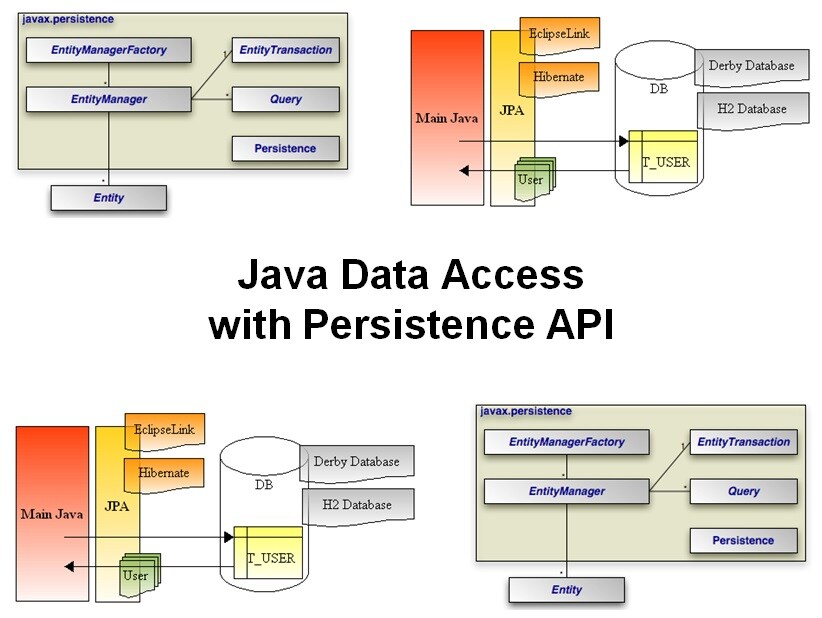-
Learning by doing
-
Trainers with practical experience
-
Classroom training
-
Detailed course material
-
Clear content description
-
Tailormade content possible
-
Training that proceeds
-
Small groups
In the course Java Data Access with JPA Object Relational Mapping with the Java Persistence API 2.x is on the agenda.
After an overview of the data access capabilities in Java, including JDBC, and the challenge they face, the basic concepts and architecture of the JPA is explained. The role of the Entity Manager and the persistence.xml configuration file is discussed.
The next topic covers the concept of a JPA Entity, the lifecycle of Entities and how Entity classes are mapped to database tables. Also the various states Entities can have in relation to the database such as new, persistent, detached and removed are discussed in this respect as is the concept of merging.
Furthermore the use of annotations and XML mapping files and the role the various properties and attributes play is explained.
The various key generation strategies are discussed as well as the mapping of association relationships and the mapping of inheritance relationships between Entities. Next the possibilities of the JPA Query language, JPQL, are covered and the uses of JPA criteria and native SQL queries.
The function and operation of Entity callbacks that are called immediately before and after the execution of a persistence operation is explained and the alternative use of Entity Listener classes as well.
Part of the course program is also the treatment of interceptors which are used for crosscutting concerns like logging and security. Finally, attention is paid to the use of JPA in a Jakarta EE application, how to interact with EJBs and the method of packaging JPA entities.
Finally JPA transactions are addressed in both a desktop environment and a Jakarta EE environment.
Experienced Java developers who want to learn how to use the Java Persistence API for accessing data in databases.
Experience with Java programming and object orientation is required to participate in this course. Knowledge of database structures and SQL is beneficial for a good understanding.
The concepts are treated on the basis of presentation slides and demos. The theory is interspersed with exercises. All topics in the Jakarta EE Persistence API Developer Certified Expert Exam (1Z0-898) will be discussed. The course material is in English. The course times are from 9.30 up and to 16.30.
Participants receive an official certificate Java Data Access with Persistence API after successful completion of the course.

Module 1 : Intro Java Persistence |
Module 2 : Persistence API |
Module 3 : Mapping Persistent Objects |
| Java Persistence Traditional Persistence Transparent Persistence Persistence Technologies Direct File I/O Serialization Java Database Connectivity JDBC Architecture Executing Statements Retrieving Results JDBC Drivers JDBC URL's Problems with JDBC |
Object Relational Mapping Java Persistence API JPA Versions Entity Classes Entity Manager Persistence Context Entity Identity Entity Lifecycle Entity Relationships Persisting Objects Removing Objects Merging Objects Managing Identity |
Mapping Annotations Table Annotation UniqueConstraint Annotation Column Annotation Id Annotation IdClass Annotation GeneratedValue Annotation Version Annotation Basic Annotation Lob Annotation Temporal Annotation Enumerated Annotation Transient Annotation |
Module 4 : Mapping Relationships |
Module 5 : Mapping Inheritance |
Module 6 : JPA Query Language |
| Entity Relationship types Bidirectional OneToOne Bidirectional ManyToOne Bidirectional OneToMany Bidirectional ManyToMany Unidirectional OneToOne Unidirectional ManyToOne Unidirectional OneToMany Unidirectional ManyToMany Cascading Persist Cascading Merge Cascading Remove |
Mapping Class Hierarchies Mapping Strategies Single Table Inheritance DiscriminatorColumn Settings Single Table per Hierarchy Single Table Mapping Features Joined Subclass Strategy InheritanceType Joined Joined Subclass Per Hierarchy Table per Concrete Class Abstract Entity Classes Mapped Superclasses |
Java Persistence QL JPA QL Characteristics Query Interface Projections Subqueries Joins Update and Delete Queries Dynamic and Static Queries Criteria API Query Error Detection CriteriaBuilder Metamodel in JPA |
Module 7 : Callbacks and Listeners |
Module 8 : Interceptors |
Module 9 : Jakarta EE integration |
| Life Cycle Callback methods Entity Listeners Life Cycle Callback Rules Signature Life Cycle Callbacks Signature Entity Listeners @PrePersist and @PostPersist @PreRemove and @PostRemove @PreUpdate and @PostLoad Multiple Invocation Callbacks Invocation Order |
Interceptor Invocation Model @Interceptor Annotation Interceptor Classes Invocation Context @AroundInvoke Interceptor Lifecycle Interceptor Types Default and Exclude Interceptors PostConstruct or PostActivate PreDestroy and PrePassivate |
Enterprise Java Beans Sessions Beans Statefull and Stateless JNDI lookups EJB injection Transaction-Scoped Persistence Context Extended Persistence Context Persistence Unit Packaging in EAR files Deployment Descriptors |
Module 10 : Transactions |
||
| Data Integrity Transaction Control Begin, Commit and Rollback Demarcating Boundaries Container Managed Bean Managed Client Managed Transaction Attributes SessionSynchronization JTA Transactions Before Completion After Completion |
